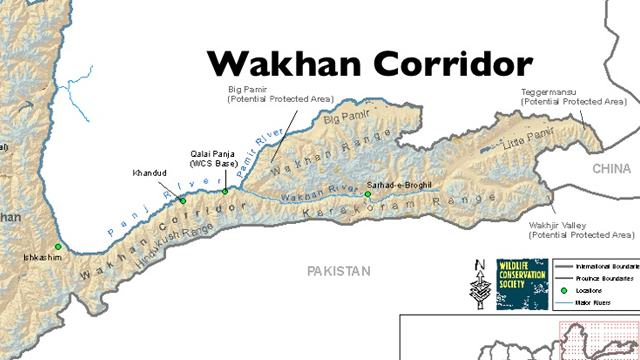The Soviet military occupation of the Wakhan salient in June 1981 proved that the inaccessible and mostly impracticable passes of the eastern Hindu Kush had not lost their importance in the imperial books.

“Geographic location, according to strategic analysts, is a matter of fate not of choice and preference”.
In the past, Wakhan has been under the control of many nations like the Persians, the Turks and the Afghans; and now Russia, China, India and Pakistan are all concerned about the fate of this strategic area. Wakhan is connected with Chitral district of Pakistan through a number of passes over the Hindukush range. For Pakistan, it is its gateway to Central Asia. But, unfortunately, Pakistani planners have focused very little on this strategic corridor that can make Pakistan a hub of transit trade.
Wakhan is the far northeastern tract of Afghanistan. It shares a 300 km long border with Pakistan in the south, and a 260 km border with Tajikistan to the northeast and west directions, and 74 km with China.
Wakhan corridor gained its strategic position in 1893, when British India and the Czars of Russia agreed to make it a buffer zone between the two empires so that the two empires do not share a boundary, for this, the Afghan Amir unwillingly accepted a subsidy of 5000 pounds. Therefore, the corridor was a political creation of the Great Game.
The Wakhan salient has once been considered the most probable route for the Russian Cossacks intending to make inroads to India, and besides a number of their liabilities, the southern passes of the Wakhan Corridor were given much more importance than some more convenient passes of the western Hindu Kush.
The two World Wars, in the first half of the 20th century, caused major shifts in the global political scenario, but did not affect the significant role of Wakhan and the Pamir plateau as far as the power game in Central Asia and its shadow on South Asia was concerned.
Stalin was of the view that the Wakhan and Pamir region is a “lighthouse for the spreading of Communism in Asia”. The idea was not new for those who knew the long standing will of Czar Peter the Great and the well-established concept of Prince Gorchakov for state behavior with neighbours. Throughout his career in the office, Leonid Brezhnev was out to materialize this doctrine of Russian expansion, and was particularly interested in southward movement.
The Soviet military intervention in Afghanistan on 27 december, 1979 and its occupation of the Wakhan salient in June 1981 proved that the inaccessible and mostly impracticable passes of the eastern Hindu Kush had not lost their importance in the imperial books.
After the Soviet withdrew from the Wakhan corridor in April 1989, the salient, under the control of Afghan askars, guided by Soviet experts, poses the same threat to its southern neighbours.
Capturing a rare geographic location in the vicinity of the “Roof of the World”, the Wakhan strip commands strategic roads towards Tajikistan, Chinese autonomous region of Xinjiang, Afghanistan and the northern belt of Pakistan.
Sarhad-e Wakhan to Gilgit and Hunza links “Afghan Tongue”, i.e., Wakhan Corridor, with the Pak-China trade route – the Karakoram highway.









Pretty sure the Wakhan border was carved out of Pakistan by the Occupying British to divide Khorasan between The Briitsh Empire and The Soviet Empire.
Afghanistan was thus created as a buffer state with it’s modern borders, the very heart of Khorasan to divide the encroaching Russian Empire from the British Empire.
Tajikistan had already fallen miserably into Russian control and therefore important to create a buffer zone between these two brutal imperial empires.
The Wakhan is Pakistani territory and can bridge Khorasan again like it was once before but through sophisticated rail, road and energy links can breath so much life into mineral rich, resource rich, culturarlly rich but sadly entire region of Khorasan.
the soviet empire didn’t exist then. it was tsarist russia back then.
Apologies imperial Russia and imperial Britain were at logger head for strategic depth and expanding their empires in Central Asia.
Unable to defeat the tribal nations in these areas they created a buffer zone.
I guess some things never change, history repeats itself and its the same strategy adopted, new players but the great game continues.
wokhan is a pakistani terrority
Wakhan never was and never will be a part of Pakistan. Wakhan has has more than a 2000 year old history as an independent territory till the bloody soviet and Britishers it was a part of Badakshan state and always will be it was not only wakkan that was split and made buffer zone it was Badakshan and wakhan is the heart of Badakshan we will regain our land from Tajikistan, Afghanistan, China and Pakistan one day long live Great and United Badakshan our land our life…….
Do it … we like badakshan, Emperor Babur loved it and send his crwn prince to rule it